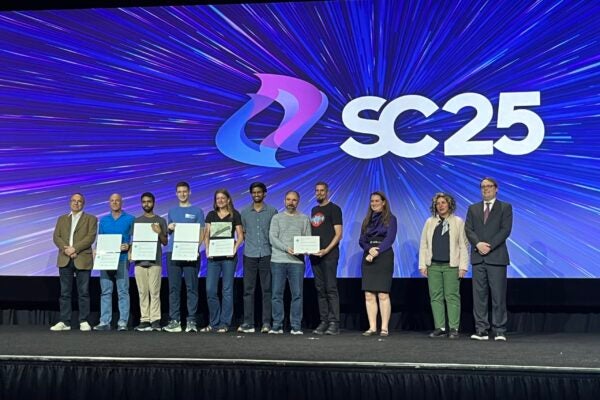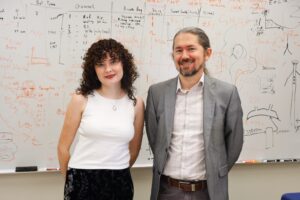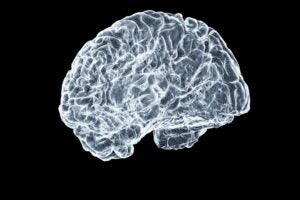A research team led by Omar Ghattas, professor of mechanical engineering and principal faculty member of the Oden Institute at The University of Texas at Austin, has been awarded the 2025 Association for Computing Machinery (ACM) Gordon Bell Prize for their work on real-time tsunami forecasting. Often referred to as the Nobel Prize of supercomputing, the Gordon Bell Prize rewards innovation in high-performance computing applications in science, engineering and large-scale data analytics. It was awarded Nov. 20 at the leading conference on high-performance computing, SC25.
The team’s pioneering research has the potential to dramatically improve early warning systems for coastal communities near earthquake and tsunami-prone regions. Their approach uses pressure sensor data from the seafloor combined with predictive physics-based models to create a digital twin that forecasts tsunami propagation. The novelty of the work lies in the team’s new digital twin algorithms, which achieve a 10-billion-fold speedup over current state-of-the-art methods. This means that a forecast that, until now, would have required 50 years of supercomputing time, can be issued by their digital twin in a fraction of a second – enough time to save lives.
“For the first time, we can combine real-time sensor data with full-physics modeling and uncertainty quantification – fast enough to make decisions before a tsunami reaches the shore,” said Ghattas, project lead. “It is a tremendous honor for our team to receive this highest recognition in the field of supercomputing.”
The research focused on the seismically hazardous Cascadia subduction zone of the Pacific Northwest – a region that extends from northern California to British Columbia, Canada where seismologists have estimated a 37% probability of a magnitude 8.0 or higher earthquake in the next 50 years. The team utilized the world’s most powerful supercomputers including Lawrence Livermore National Laboratory’s (LLNL) #1 ranked El Capitan, the National Energy Research Scientific Computing Center’s Perlmutter, the Swiss National Supercomputing Center’s Alps, and the Texas Advanced Computing Center’s Frontera. Extensions of this digital twin framework could enable model-predictive early warning systems for many other hazards, from wildfires and severe weather to contaminant spread and threat detection.
In addition to Ghattas, members of the research team include Stefan Henneking, Sreeram Venkat and Milinda Fernando (Oden Institute); Alice-Agnes Gabriel (Scripps Institution of Oceanography at the University of California San Diego); and Veselin Dobrev, John Camier and Tzanio Kolev (Lawrence Livermore National Laboratory).
“By combining the power of El Capitan with advanced high-order finite element algorithms, we were able to solve problems with an unprecedented 50+ trillion unknowns on 40K+ GPUs, while maintaining excellent parallel efficiency,” said Kolev, computational mathematician at Lawrence Livermore National Laboratory.
“As an earthquake seismologist, what excites me most is that this digital twin links the full physics of megathrust dynamic rupture and tsunami generation with real-time seafloor observations,” said Gabriel, associate professor at the Institute of Geophysics and Planetary Physics at Scripps Institution of Oceanography.
How the Digital Twin Works
The digital twin framework uses seafloor pressure data in the subduction zone, along with 3D coupled acoustic–gravity wave equations, to infer earthquake-induced spatiotemporal seafloor motion using novel Bayesian inversion algorithms. The inferred seafloor motion then provides the source to simulate the tsunami propagation toward coastlines and issue forecasts of wave heights at specified locations with quantified uncertainties. The entire framework executes in a fraction of a second, providing actionable early warning to inform evacuation decisions and first responders ahead of tsunamis, which can arrive on the coast in as little as 15 minutes following an earthquake.
The team’s 10-billion-fold speedup is achieved through the design of novel GPU algorithms for real-time Bayesian inversion. The digital twin is built and deployed in two phases: a computationally demanding offline phase that precomputes efficient representations of the inversion operator, and an online phase that issues real-time probabilistic tsunami forecasts when an earthquake occurs. In the offline phase, the research team employed the MFEM finite element library to solve the 3D acoustic–gravity wave equations, scaling up the solver with near-ideal parallel efficiency to 43,520 GPUs on the world’s fastest supercomputer, LLNL’s El Capitan. In the online phase, the new Bayesian inversion algorithms permitted inference and prediction on a more modest cluster of 512 GPUs in less than a second.
The Bell Prize-winning research, “Real-Time Bayesian Inference at Extreme Scale: A Digital Twin for Tsunami Early Warning Applied to the Cascadia Subduction Zone,” was published Nov. 15 as part of the SC25 conference proceedings. Innovations reported by the paper include:
- Fastest time-to-solution of a PDE-based Bayesian inverse problem with 1 billion parameters in 0.2 seconds
- Largest-to-date unstructured mesh finite element simulation with 55.5 trillion unknowns on 43,520 GPUs of LLNL’s El Capitan system
In addition to the Bell Prize, the team received two other awards at SC25: the Hyperion Research HPC Innovation Excellence Award and the HPCWire Reader’s Choice Award for Best Use of HPC in Physical Sciences.
Awarded annually, the ACM Gordon Bell Prize honors outstanding achievements in high-performance computing applications. The award is named after the pioneering computer architect who founded the U.S. National Science Foundation’s Directorate for Computer and Information Science and Engineering.




